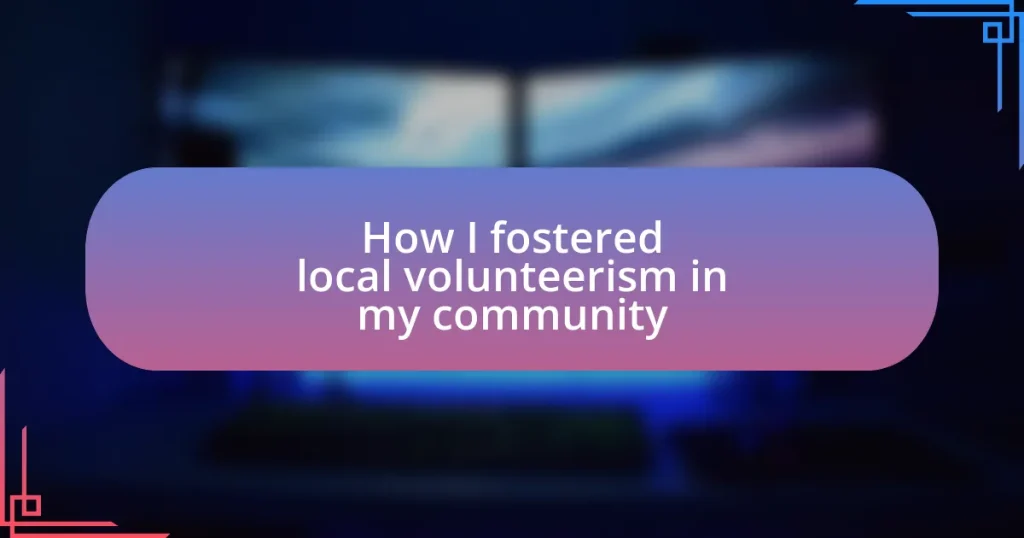Key takeaways:
- Local volunteerism enhances community ties and individual growth, driven by diverse motivations and connections.
- Identifying community needs through direct conversations and feedback tools is essential for effective volunteer efforts.
- Building partnerships with organizations can amplify resources and community trust, leading to a more significant impact.
- To retain volunteers, recognition, community building, and skill development are crucial for maintaining engagement and commitment.
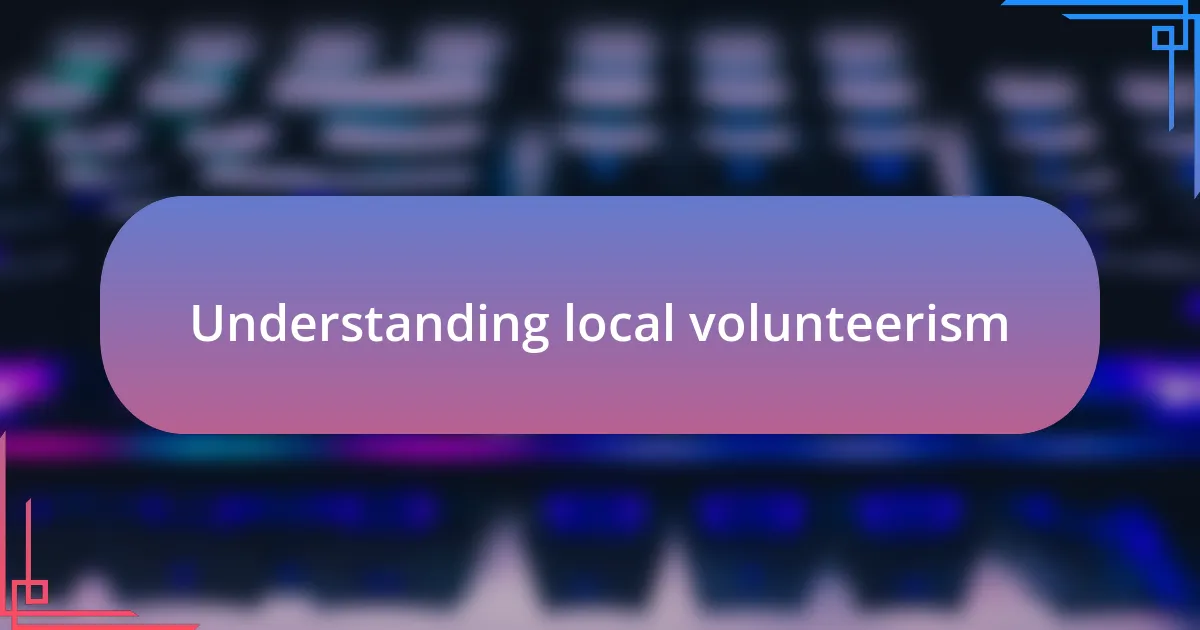
Understanding local volunteerism
Local volunteerism is a powerful force that can create tangible change in communities. I remember my first experience volunteering at a local shelter; the connection I felt with the people I was helping opened my eyes to the struggles many face daily. How often do we take for granted the resources we have while others are seeking just a little assistance to get back on their feet?
Understanding what drives local volunteerism involves recognizing the diverse motivations of volunteers themselves. Some are compelled by a personal cause, while others simply want to connect with their neighbors. Reflecting on my journey, I often wonder: what if more people understood the profound impact their involvement could have—not just on others, but on their own lives as well?
Moreover, local volunteerism thrives on community bonds. It’s not just about giving time; it’s about fostering relationships and cultivating trust within the neighborhood. I’ve seen firsthand how organizing community clean-ups or food drives has sparked friendships and collaboration among individuals who otherwise might not have crossed paths. Isn’t it remarkable how a shared purpose can weave together a diverse tapestry of people?
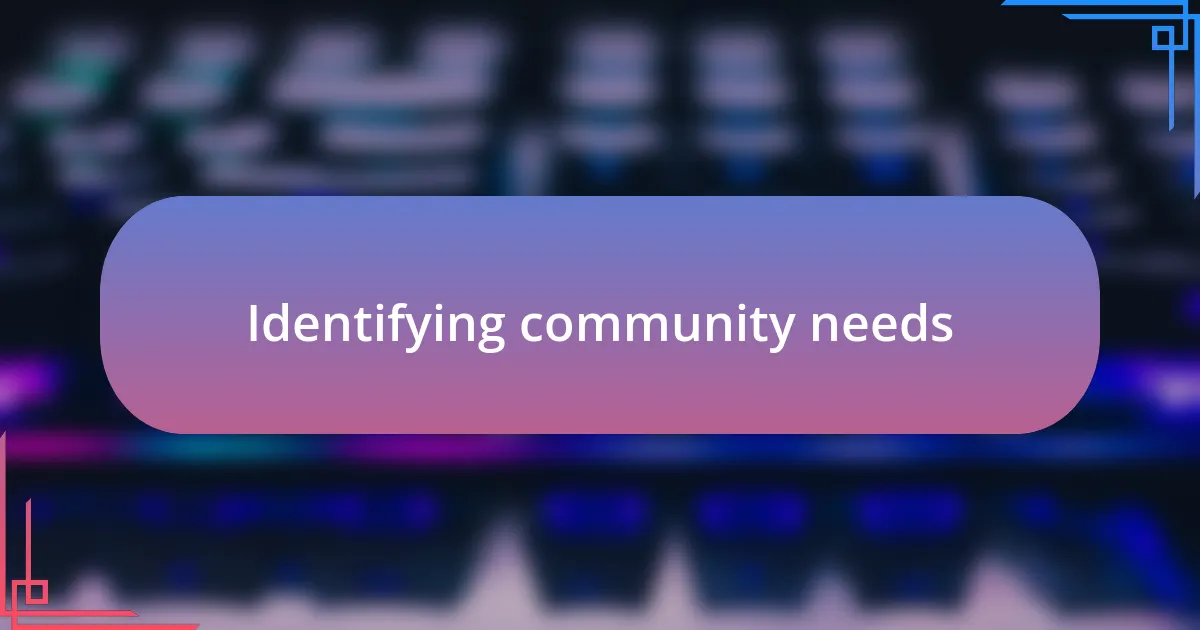
Identifying community needs
Identifying community needs is crucial for fostering effective volunteerism. I recall my early days of engaging with my neighborhood when I decided to host a casual coffee chat at the local park. It was during this informal gathering that residents opened up about challenges like food insecurity and lack of youth programs. Listening to their stories revealed the gaps in services that many had silently endured, reinforcing the importance of direct conversations in identifying true community needs.
I often emphasize the value of surveys and feedback forms to gauge public sentiment. You might be surprised to learn how revealing these can be; in one instance, a simple online survey revealed a strong desire for more environmental initiatives, which had gone unnoticed until I launched it. When you create an opportunity for people to voice their needs, it can lead to surprising insights that shape effective volunteer efforts.
Another approach I’ve found effective is collaborative community meetings. In my experience, when people from diverse backgrounds come together, it sparks rich discussions about unmet needs. I vividly remember one session where an unexpected call for mental health resources emerged, highlighting how crucial it is to provide a safe space for community members to share their concerns. These experiences taught me that identifying needs is an ongoing process, shaped by active engagement and awareness.
| Method | Insights Gained |
|---|---|
| Coffee Chats | Understanding personal struggles and urgent needs, fostering connections among residents. |
| Surveys | Revealing hidden needs and interests, leading to targeted volunteer initiatives. |
| Community Meetings | Encouraging dialogue around diverse topics, including mental health and environmental issues. |
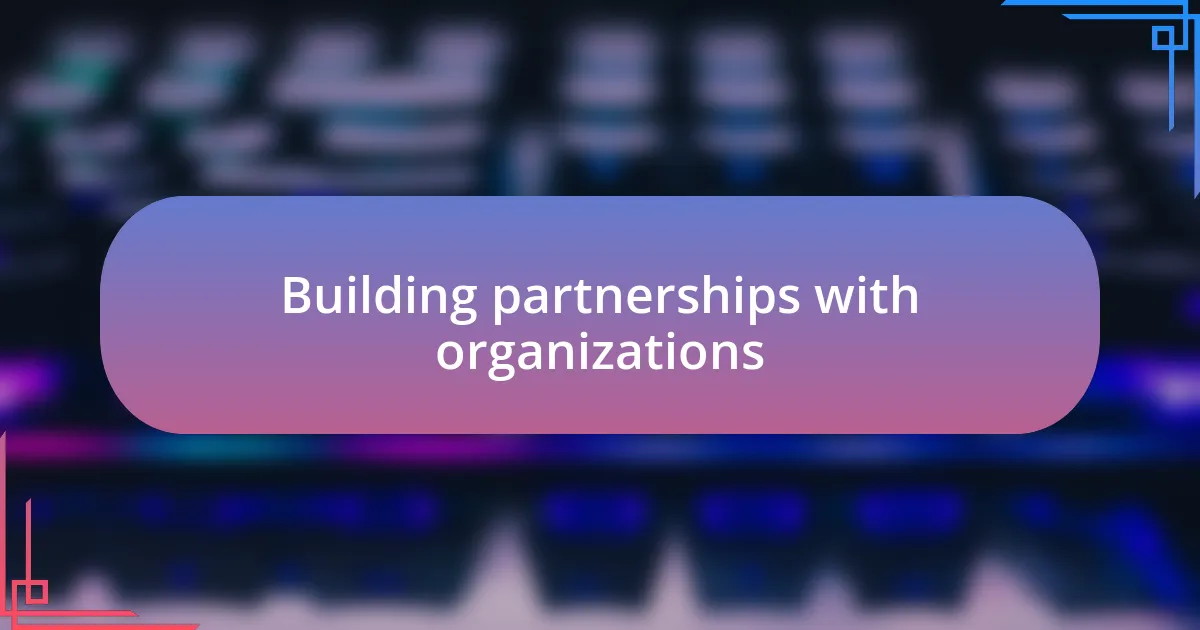
Building partnerships with organizations
When I think about building partnerships with organizations, I remember feeling overwhelmed at first. It seemed like such a daunting task to reach out to established entities. However, I soon realized that these partnerships could unlock vast resources and expertise. One of my most impactful collaborations was with a local food bank. By aligning our volunteer efforts, we not only expanded our reach but also deepened the impact we could make together.
Here are some key insights I’ve gathered from my experiences in establishing these partnerships:
- Shared Goals: Collaboration becomes seamless when both organizations have aligned missions. For instance, partnering with local youth programs to provide mentorship resulted in more robust participation from the community.
- Resource Mobilization: Working together can amplify what each organization brings to the table. I witnessed this when a local school supplied us with volunteers who were eager to participate, enriching our initiatives.
- Community Trust: When organizations partner, it signals unity to the community, fostering trust in our efforts. I’ve observed that this trust broadens outreach, as residents feel more confident in supporting initiatives that have collective backing.
- Skill Sharing: Each organization has unique strengths, and exchanging knowledge can enhance programs significantly. I learned from a nearby arts organization that incorporating creativity into community service drew a more diverse group of volunteers.
Establishing these connections is a continuous journey, but the rewards are undeniably enriching, transforming not just projects but also the community spirit.
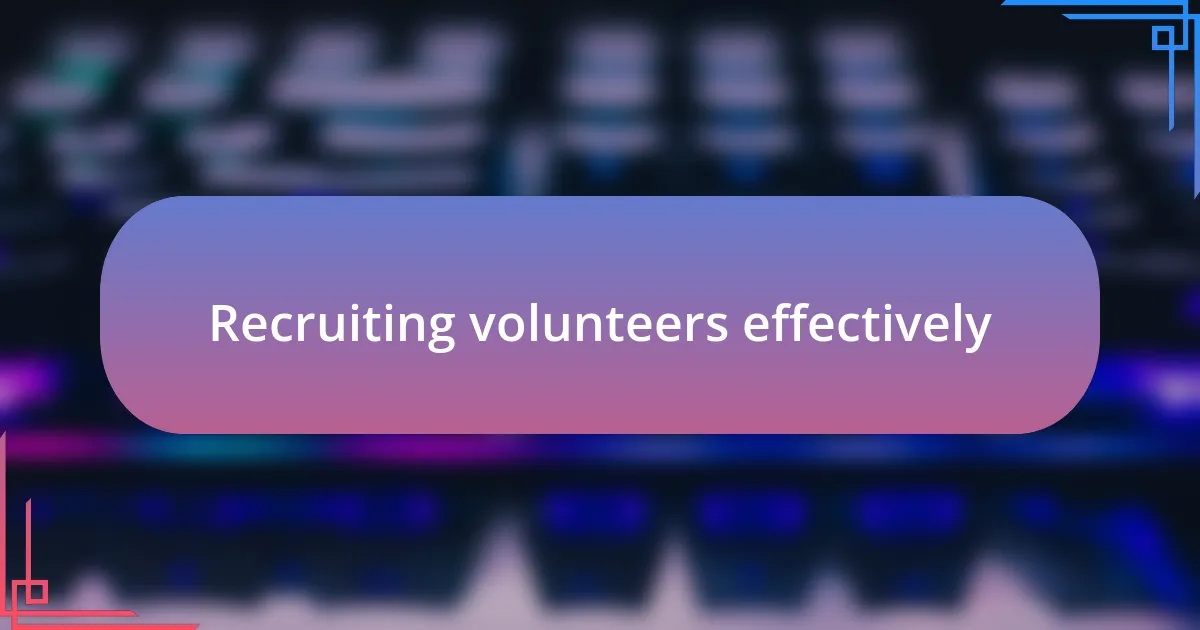
Recruiting volunteers effectively
When it comes to recruiting volunteers effectively, I’ve found that the message you share plays a crucial role. I remember crafting a simple flyer for a community clean-up event, and instead of clunky text, I shared a story about how a clean park transformed my childhood memories. This narrative approach resonated with people, drawing them in and making them feel a personal connection to the cause.
Another aspect that has significantly impacted my recruiting success is highlighting the specific roles available. Rather than leaving potential volunteers wondering how they could help, I created clear descriptions for each task. For instance, during a local festival, I posted a call for “happy greeters,” emphasizing how important a friendly face is to create a welcoming atmosphere. By making volunteer roles distinct and relatable, I noticed a remarkable increase in individuals eager to sign up.
Moreover, fostering a sense of community among volunteers can amplify the recruiting process. At one of my events, I organized a small meet-and-greet before the action started. This simple gathering allowed people to connect on a personal level, sharing their motivations and experiences. Watching them bond over a common goal not only made the event more fun but also encouraged many to return for future initiatives. Isn’t it incredible how a little social interaction can turn volunteers into lifelong advocates for your cause?
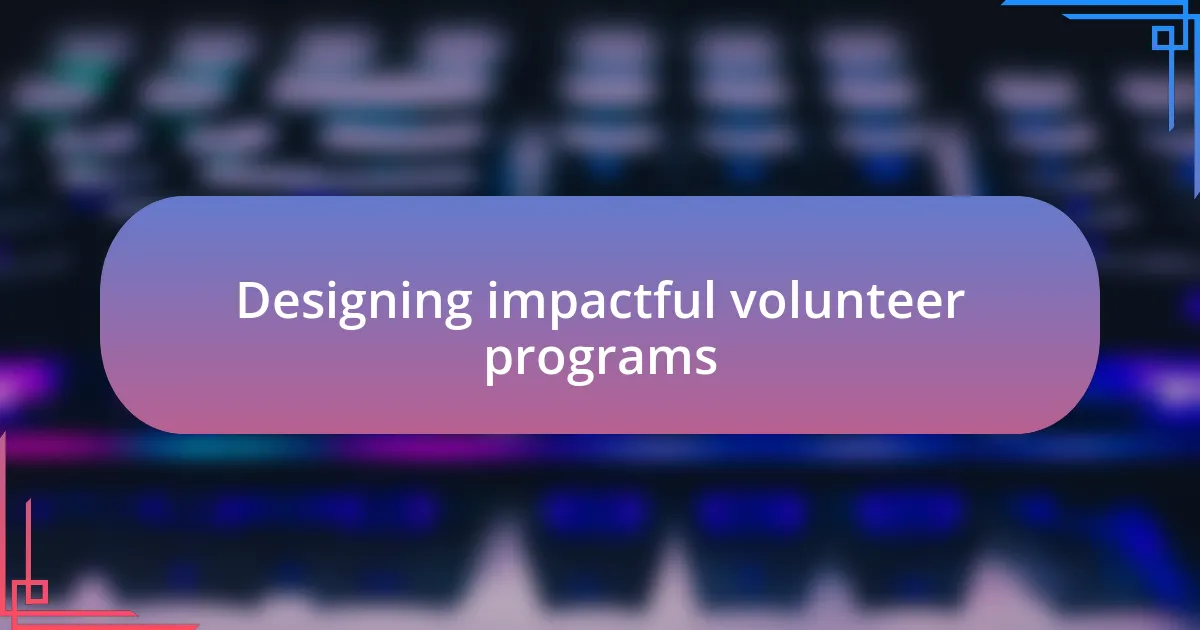
Designing impactful volunteer programs
Designing impactful volunteer programs starts with understanding the interests and strengths of your volunteers. I remember sitting down with a diverse group of community members to brainstorm what excites them. It was eye-opening to see how different personalities could contribute uniquely, from organizing events to behind-the-scenes administration. This collective input not only shaped our programs but also made the volunteers feel valued and invested—don’t you think that connection can enhance their commitment?
Creating a structured yet flexible framework is essential for impactful programs. At one point, I introduced an online platform where volunteers could sign up for tasks that matched their skills and availability. I found this approach not only streamlined our operations but also empowered volunteers to take ownership of their contributions. When individuals feel in control, they are more likely to invest time and energy into the program, don’t you agree that such ownership breeds enthusiasm?
Regular feedback mechanisms play a pivotal role in refining these programs as well. After a large initiative, I always made it a point to gather thoughts from participants about what went well and what could improve. One time, a volunteer shared that they felt overwhelmed during a large event, which prompted me to create smaller, more manageable teams for future initiatives. This little change resulted in an uptick in volunteer satisfaction. It’s amazing to consider how listening can transform not just the programs but also the relationships we build within our community.
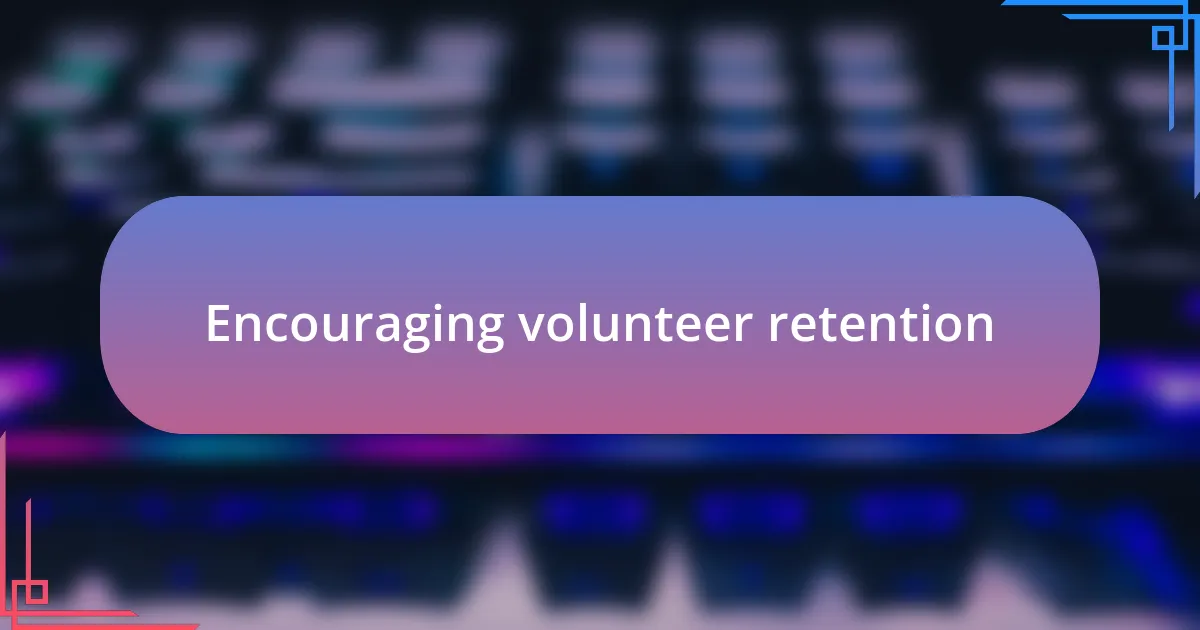
Encouraging volunteer retention
One effective strategy I employed to encourage volunteer retention was to recognize and celebrate their contributions regularly. I remember organizing a quarterly appreciation event where we highlighted individual efforts and shared success stories. The joy on their faces when receiving recognition was palpable; it reinforced their sense of belonging and importance within the team. Isn’t it fascinating how a simple “thank you” can cultivate loyalty?
Another key aspect was fostering a sense of community among volunteers. I initiated informal meet-ups, where everyone could share their experiences and connect on a personal level. This approach transformed our volunteer group from a collection of individuals into a close-knit community. I could sense the difference during our projects—the laughter, camaraderie, and sheer enthusiasm made the work feel lighter and more fulfilling. Wouldn’t you agree that strong relationships can make difficult tasks easier to tackle?
Finally, providing opportunities for skill development was crucial in keeping volunteers engaged. I created workshops that allowed our team to learn new skills pertinent to our cause, whether it was public speaking or project management. Witnessing volunteers step out of their comfort zones and thrive was incredibly rewarding. It’s interesting to think about how the prospect of personal growth can motivate individuals to stay committed, isn’t it?
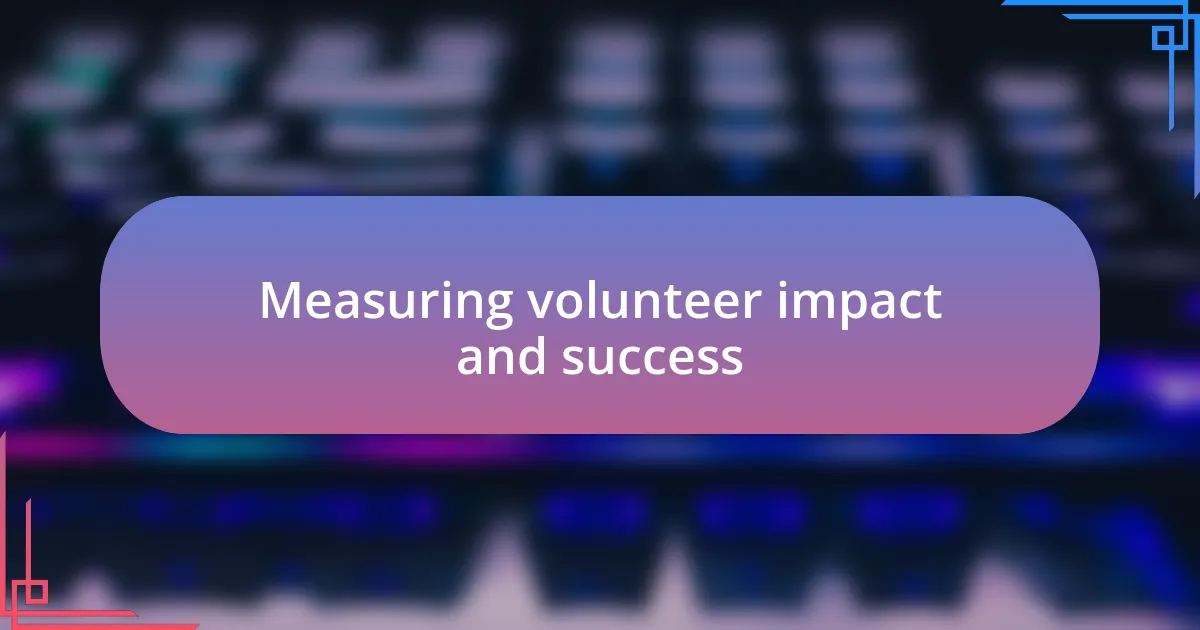
Measuring volunteer impact and success
Measuring the impact of volunteer efforts can seem daunting, but I found that setting specific, measurable goals made a significant difference. For instance, I implemented surveys to gather feedback from both volunteers and the communities we served. Seeing the impact of our work reflected through heartfelt testimonials was like a validation of all our efforts, reinforcing the idea that we truly were making a difference. Have you ever experienced the thrill of knowing your contributions resonated with others?
Tracking volunteer hours also played a pivotal role in illustrating our collective success. Each time I aggregated this data, it became more than just numbers; it transformed into stories of impact that I could share with potential supporters. I vividly recall presenting this information at a local event and witnessing a surge of interest in our initiatives. It was gratifying to know that tangible metrics could attract even more volunteers to our cause. Isn’t it powerful to think that what starts as a few hours can blossom into a wave of community support?
Furthermore, celebrating milestones allowed us to make our successes visible in a way that ignited excitement among the volunteers. I organized small events when we reached specific targets—like distributing a set number of meals or planting a certain number of trees. The energy in the room during these celebrations was infectious, leaving everyone motivated to tackle the next milestone. Have you noticed how shared victories can elevate the spirit of a team?











